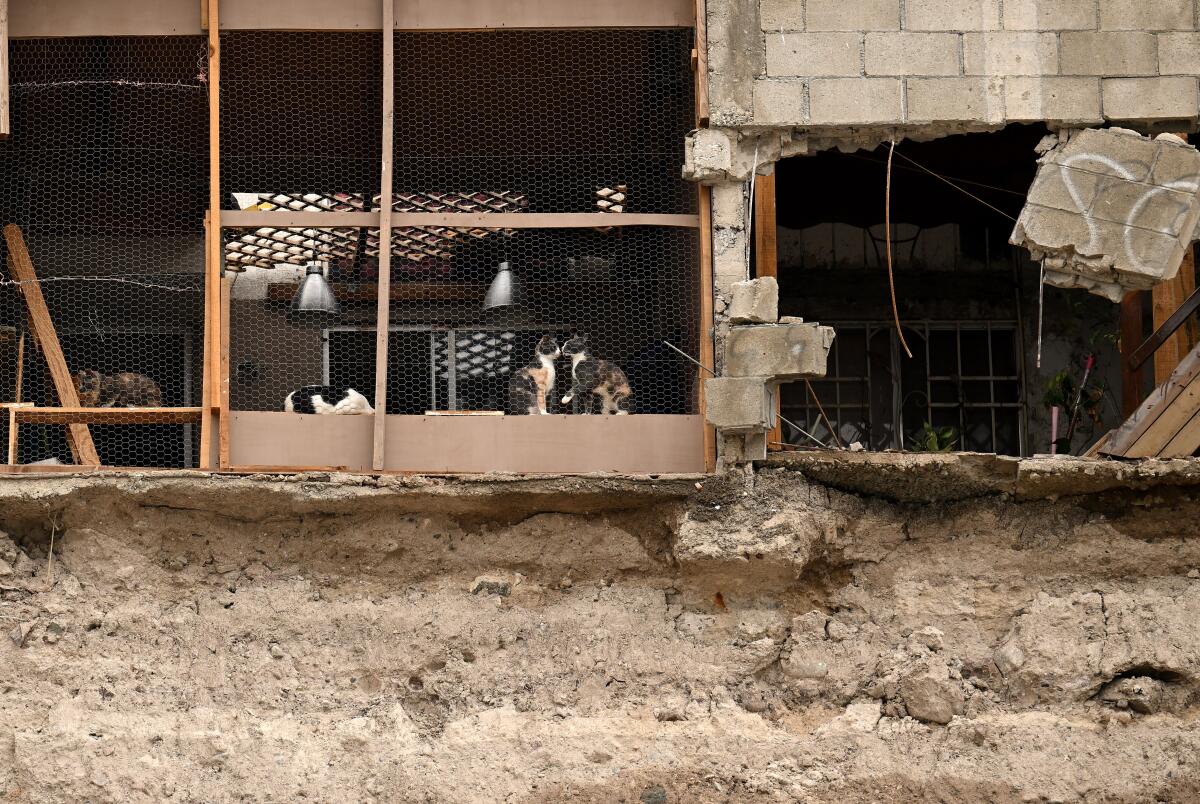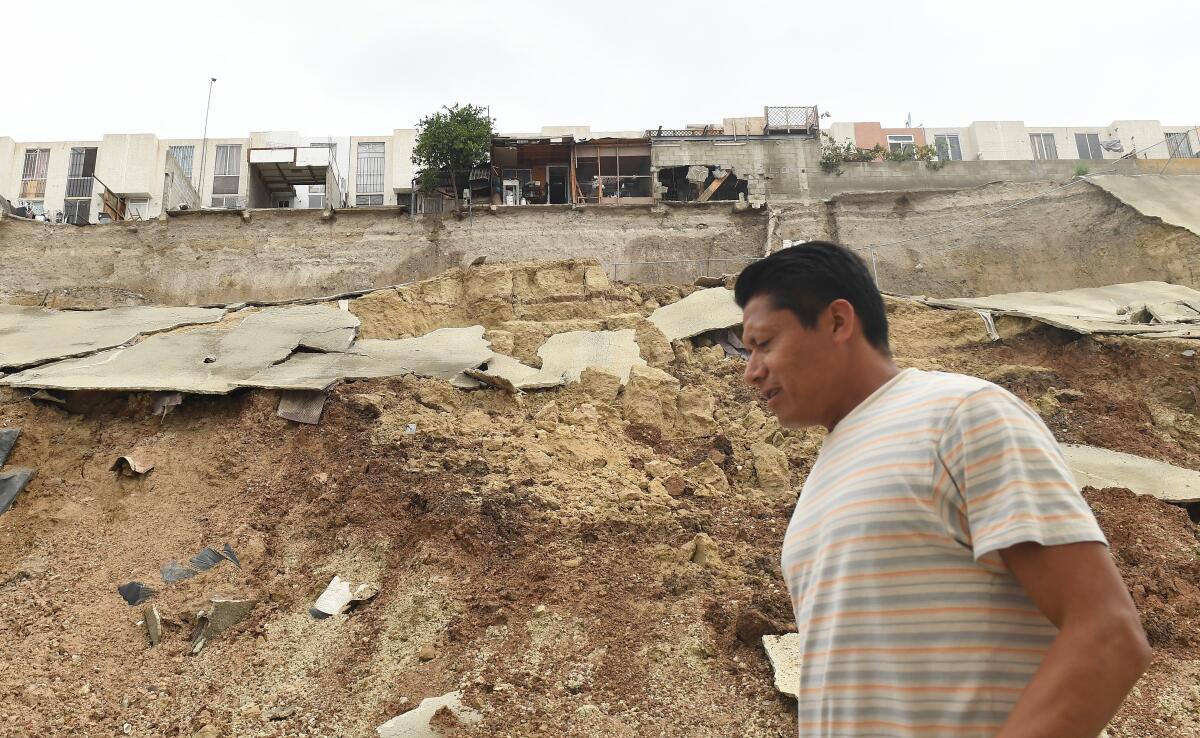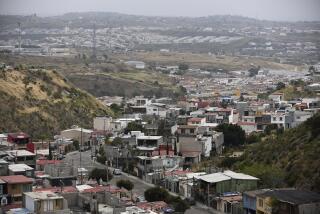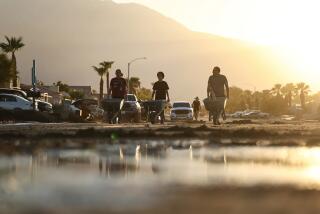In largely spared Tijuana, life for many already ‘back to normal’ a day after Hilary

- Share via
TIJUANA — The morning after Hilary passed through Tijuana, life for most of the city’s residents was largely back to normal. Commuters clogged mostly clear highways and even on side roads, deep pools of standing water were an uncommon sight.
Despite hours of rain and doomsday forecasts, the storm had done little damage to the city of about 2 million people.
For many Tijuanans, it’s no surprise that the weakened storm took a path that ultimately spared the city from devastation. Major storm systems have a way of missing Tijuana, said taxi driver Erick Machado Gonzalez.
“That’s why people come to Tijuana. We don’t have hurricanes and those things,” he said. “God knows we can’t handle them here.”
This time, fortunately, most people in this city on the Mexico-U.S. border didn’t have to.
Gerardo López, the Tijuana secretary of welfare, praised the efforts of Mayor Montserrat Caballero, saying her preventative efforts helped the city “avoid some misfortune.”

More than 1,000 troops fanned out across Tijuana and the rest of Baja California on Sunday, clearing road hazards and rescuing people from floodwaters. Rock slides, flooding and washouts closed some highways and roads late Sunday, and video from the coast showed submerged cars and trucks stuck on roads south of the city.
Authorities responded to dozens of emergency calls, mostly reports of power outages and street flooding. But officials said there were no major incidents or mudslides stemming from the storm, and only a couple of dozen traffic accidents.
Some people in the border city and along the nearby coast reported cellphone and internet outages, and officials in Baja California’s harder-hit capital city — Mexicali — warned Sunday of power outages and water problems.
It was still raining Sunday when authorities canceled classes across the state for the following day. But by daybreak, the skies had cleared over Tijuana and many of the roads were dry.
Rigoberto Cano is a construction worker originally from Chiapas who lives in a shanty town by the highway in an impoverished section of Tijuana’s east side. He said that as Hilary made its way up the Baja California peninsula, he was “a little bit worried and a little bit not.”
He stocked up on toilet paper and water before the storm hit, but he said he didn’t take any other precautions.
Despite the fact that the ramshackle home he rents sits in a low-lying area, he said it was unscathed.
“We didn’t lose power,” he said. There was “a little bit of floodwater but not too bad. Back to normal now.”
On Monday morning, Tijuana city officials shuttered the temporary shelters they’d opened days earlier before the storm. The few dozen people living in high-risk areas who had come in to wait out the bad weather on dry cots returned home by midday.
Yet many residents know their homes still face threats from future storms in this hilly, mudslide-prone city.
Oscar Soto looked out over a shopping mall from a tall cliff on Tijuana’s east side Monday morning. The 74-year-old pointed down at a massive concrete retaining wall that was badly damaged by Hilary’s torrential rains.
The wall was built to protect several condo complexes perched on the cliff’s edge from landslides. And in the wake of the storm, the wall was buckling under the weight of the earthen mass, threatening dozens of residents.
“Look at this,” Soto said. “These houses might fall down.”
The precarious scene is not an uncommon one in Tijuana, where the wreckage of several buildings that were destroyed during previous storms can be seen from a crosstown highway. It’s a result of homes being built too close to the edges of cliffs with insufficient support.
Soto’s condo is set back farther from the edge, which he said provides a measure of comfort. But he still took precautions before Hilary arrived.
“We covered everything and blocked the windows,” Soto said. “We prepared, but nothing happened. It rained and that was about it.”
Even in coastal areas to the south of Tijuana — places where cars and trucks had been submerged less than a day earlier — the sun was shining and life was returning to normal for many.

But for some Tijuanans, Hilary was not the disaster most on their minds this week. During a shopping run midday on Monday, Montserrat Guzman said she had weathered the storm at her mother-in-law’s home — which is where she and her children have been living since a mudslide hit their development six months ago.
They’d been hoping to move back in by now, but in July they had to move out all their belongings after contractors working in the area set off a landslide.
Now, her home is still standing, but uninhabitable — just like those of many of her former neighbors. They’re hoping authorities will offer them a solution.
“We need to see what’s going to happen,” she said, before turning from hope back to worry. “We are about to lose our houses.”
More to Read
Sign up for Essential California
The most important California stories and recommendations in your inbox every morning.
You may occasionally receive promotional content from the Los Angeles Times.















